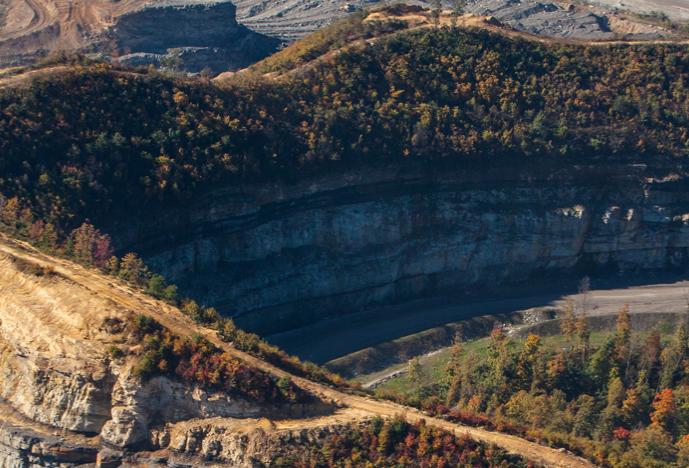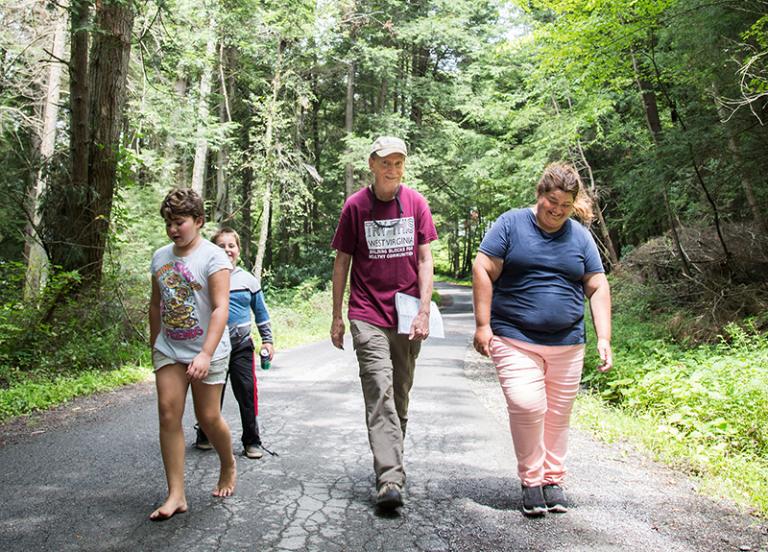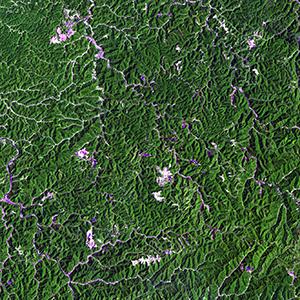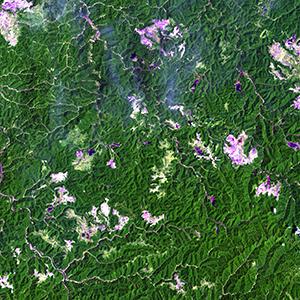A Canary Named West Virginia
Human health and the environment’s health are inseparable
- 16 minute read
- Feature

Sandra Keeney grew up on Wolf Creek in Fayette County in southern West Virginia. She lives a mile out Wolf Creek Road from me.
“My grandparents, Betty and Hayward Backus, bought this farm right on the creek in 1962,” Sandra says. “I was born in 1980 right here. We swam and played in the creek when I was growing up. We had a well next to the creek, where we got all our water. In 1984, my grandmother heard about the PCBs [polychlorinated biphenyls] at Minden and told us we should stop drinking the water.”
Wolf Creek begins on Summerlee Mountain about five miles west of Sandra’s home. The creek runs past the old Summerlee mine slate dump, where coal waste has been piled for years. In 1994, federal inspectors found metals and acid draining from the slate dump into the waters of Wolf Creek.
In 2016, Sandra learned that pollution from a new source was getting into the creek. The Danny Webb Construction Company of Lochgelly, West Virginia, was injecting fracking discharge, a water-chemical mixture produced in drilling for natural gas, into old gas wells along Wolf Creek. A study published that year by the U.S. Geological Survey in Environmental Science and Technology reported that strontium, barium, lithium, and radioactive compounds were leaking into the creek from the injection facility. A separate study that same year in Science of the Total Environment by researchers from Duke University found endocrine-disrupting compounds downstream from the injection site. Despite the company’s repeated violations of state regulations, the West Virginia Department of Environmental Protection had not shut them down.

In January 2017, Sandra’s children developed sores—blistered and red rashes—on their arms and face after bathing in water from the family’s well. Sandra took the kids to their doctor. The sores, the doctor told her, were chemical burns.
There is a sandy bank along the creek that runs next to the family’s fields. “This used to be our favorite playground,” say Sandra’s children. “But now mom says we can’t play here anymore.”
Insults and Injuries
Ten years earlier, in neighboring Boone County, near the state capital of Charleston, Jennifer Hall-Massey and her family had been having problems similar to those Sandra’s family later experienced. As reported in the New York Times, the Hall-Massey family noticed that the water from their well had grown cloudy and foul smelling. Jennifer’s children developed skin sores after bathing, and their teeth began to decay rapidly. Tests showed the presence of metals including arsenic, lead, barium, manganese, and nickel in their tap water. In 2009, the year the Times reported her story, Jennifer and nearly 300 of her neighbors sued nine coal companies, including the coal-mining giants Massey Energy and Patriot Coal, charging them with discharging dangerous waste into local water supplies. State records revealed that coal operations within eight miles of Hall-Massey’s home had injected more than 1.9 billion gallons of coal slurry into the ground since 2004. The state’s environmental protection department sided with the companies, claiming it could find no evidence of the pollution. The suit was settled in 2012 for an undisclosed amount.
In 2004 in nearby Mingo County, 700 residents from four communities sued Rawl Sales and Processing, a subsidiary of Massey Energy, for polluting their public water systems by pumping 1.4 billion gallons of toxic coal slurry into underground mines. The suit was settled for $35 million in 2011.
As wells and public water systems serving small communities closed because of disruption and pollution from surface mine blasting and coal slurry injection, more and more communities became connected to large corporate water systems, especially the system operated by West Virginia American Water Company in Charleston.
On January 9, 2014, 11,000 gallons of crude MCHM (4-methylcyclohexane methanol) and polyglycol ethers, agents that remove impurities from coal and thus increase its value, leaked from a 48,000-gallon above-ground tank owned by Freedom Industries into the Elk River, about one and a half miles above the intake for West Virginia American Water. Three hundred thousand people living in nine counties, an area that included the city of Charleston, were without safe drinking water for more than a week. Residents reported that tap water had a sweet, licorice odor. Hundreds of people were treated in local emergency departments for nausea, vomiting, and rashes. Nearly 700 called the West Virginia Poison Control line.
At community meetings and legislative hearings during that water crisis, residents and business owners expressed anger and frustration, repeating complaints heard since the 1980s that West Virginia had become a “national sacrifice zone”—an “extraction colony.”
Open Wounds
Mountaintop removal (MTR) mining is a growing concern for people living in affected communities in West Virginia and Central Appalachia along with those in the environmental movement in this region.
A combination of state and federal actions, played out over decades, gave birth to the MTR industry of today. MTR is a form of strip mining, a type of surface mining that has been going on since the early 1960s. In the late 1970s there was a move to more tightly regulate strip mining nationally, but the resulting federal law contained a loophole that opened the way to MTR. In 1990, this loophole began to attract the attention of the mining industry. In that year, Congress amended the Clean Air Act to encourage utilities to burn lower sulfur coal, a form of coal abundant in southern West Virginia and easily accessed through surface mining. Around the same time the West Virginia state legislature, hoping to stimulate job creation, established so-called super tax credits for coal companies. The companies quickly took advantage of the credits to buy giant excavation machines and other surface-mining equipment.
Mountaintop removal mining took off.

Compared with underground mining, MTR is more cost effective as it requires fewer workers and gives access to coal seams normally too thin to mine. How it allows this access is part of the concern: it literally removes the tops of mountains. For miles and miles, mountaintops get cut off and the overburden, the rock and soil that lie above the coal, is dumped into surrounding valleys.
The devastation and scale of MTR is unimaginable until you see it. Whole valleys are filled with overburden. Streams are buried and polluted in violation of the Clean Water Act. Illegal discharges of mine runoff are so common that personnel in the state’s Department of Environmental Protection cannot keep up, even if their actions were not being blocked by coal-friendly government officials.
Stewards of the Land
West Virginians have been protesting the environmental and health impacts of mining and logging for more than a century.
An early advocate for the state’s environment was native son Alonzo Beecher Brooks. In 1911, Brooks, a forester who lived at the turn of the twentieth century, wrote a 480-page report for the West Virginia Geologic Survey describing the importance of forest preservation and the harmful public health impacts of overlogging.
In the mid-1960s, the West Virginia Highlands Conservancy began to protect some of the most pristine areas of the state from ill-conceived highways, dams, logging, and mining projects. The group formed one of the first mining committees to oppose mountaintop removal. From those efforts grew the West Virginia Environmental Council, which formed in 1989. The E-Council, as it’s known, has had many important legislative achievements over the past thirty years, including landmark legislation for groundwater protection.

In 1987, a group of Huntington, West Virginia, residents organized to oppose construction of a huge BASF Chemical Company hazardous waste incinerator on the Ohio River at nearby Ironton, Ohio. Calling themselves the Ohio Valley Environmental Coalition, they successfully stopped the incinerator project, an action that has helped protect the Ohio River and waters all the way to the Gulf of Mexico. In the three decades since that action, coalition members have led efforts to protect community health and the mountain environment by effectively exposing and opposing the public health hazards of MTR, deep oil and gas fracking, and related pipeline projects throughout West Virginia.
Appalachian Mountain Advocates, a group that began its work in 1998, has, according to its founder, Joe Lovett, “worked successfully to hold the coal industry accountable.” That same year, Lovett, an environmental attorney, brought his first case challenging MTR. Since then, Lovett and his team of attorneys have brought a series of lawsuits against MTR mining operations on behalf of communities affected by this form of mining. Many of the lawsuits have resulted in landmark decisions. “It’s my view,” says Lovett, “that we need to move to renewable energy in this country.”
In Fayette County, where I live, a group called Headwaters Defense formed in 2015 to do what the state’s Department of Environmental Protection seems unwilling or unable to do: stop Danny Webb Construction from injecting fracking waste into old gas wells near Wolf Creek. Led by local residents Brandon Richardson, Brad Keenan, and Britt Huerta, Headwaters collected 5,000 signatures from county residents in 2015, prompting the Fayette County Commission to adopt an ordinance banning disposal of fracking waste in the county. The celebration was short, however, for natural gas giant EQT went to court to block enforcement of the ordinance. In late August, the U.S. Fourth Circuit Court of Appeals in Richmond, Virginia, decided in favor of EQT.
The group has also taken up the cause of Sandra’s family and other Minden residents who live next to the Superfund site created by the dumping of PCBs from mine transformers in the 1970s and 1980s. In a recent interview for a Univision documentary on PCBs, Richardson said, “I fear that not only will the people go extinct in Minden, but I fear that the history of PCB contamination in Minden will be swept under the rug. No one will know that this is a mass gravesite of a once bustling coal mine town filled with people who loved each other.”
The Evidence, Please
Ten years ago, Michael Hendryx was new to the faculty of community medicine at West Virginia University. Although his specialty is epidemiology, as a newcomer to the state he had not known of the health effects that coal mining, especially MTR, has had on surrounding communities.
He soon learned.
During the next seven years, Hendryx and colleagues published more than eighteen peer-reviewed articles on the damaging health effects of MTR mining. Their research showed that in rural communities near MTR mining operations, residents have higher cancer rates (Journal of Community Health, 2012), more cardiovascular disease (American Journal of Public Health, 2008), and lower quality of life (Public Health Reports, 2009) than people who live in rural areas of the state that don’t have mining operations. In addition, the researchers chronicled socioeconomic differences: Communities in the shadow of these mining operations also had degraded water quality (Water Quality, Exposure and Health, 2012) and higher rates of poverty (Journal of Health Disparities Research and Practice, 2010).
From a generational health-effects perspective, their most important study may be one that reported the association between MTR mining and birth defects. In that paper, which appeared in May 2011 in Environmental Research, Hendryx and colleagues reported a heightened prevalence of birth defects in MTR counties compared to nonmining counties of central Appalachia, after controlling for covariates such as cigarette smoking during pregnancy and socioeconomic disadvantage.
In July 2017, Hendryx testified before a National Academy of Sciences panel that there is sufficient evidence of public health harm to end the practice of MTR. Charleston Gazette reporter Ken Ward, who covered Hendryx’s appearance, wrote “West Virginia political and governmental leaders have mostly either ignored the growing body of science on mountaintop removal’s health effects or tried to belittle the work. Coal industry officials have, likewise, attacked the studies, funding a large effort to discredit the work.”
Ward’s assessment was an understatement. One month after Hendryx’s appearance, the U.S. Department of the Interior, acting under a directive from the White House, halted a large, long-term study by the National Academies of Sciences, Engineering and Medicine into the human health effects of surface mining such as MTR. The brake on funding, according to a department statement, is part of a budget review of all grants greater than $100,000.
Coal-Fueled Heat
The state-based environmental protection movement has been vocal, but the coal industry has been far from silent.
In 2008, the industry launched the Friends of Coal campaign. Funded by millions of dollars from the West Virginia Coal Association, the Kentucky Coal Association, the Virginia Mining Association, and the National Mining Association, the campaign is a multimedia effort to convince people in the state that environmental laws and regulations are unreasonable, unnecessary, damaging to the state’s economy, and deadly to the jobs base.
At car shows, football games, and community picnics and on yard signs, bumper stickers, and license plates, the message is that efforts to preserve and protect the environment represent a war on coal—and on West Virginia. The strategy is to conflate the proud tradition of sacrifice and hard work by coal-mining families with the single-minded corporate interests of maximizing short-term profits at any cost.
The Friends of Coal campaign and its “war on coal” message were particularly fierce during the Obama administration, when their attacks on the president and the U.S. Environmental Protection Agency were common. In a state that is pro-gun, socially conservative, and 94 percent white, it was often not hard for those arguments to gain traction.
State-based environmental groups have not given up, however. Faced with the Friends of Coal campaign and its messages, they have organized a Friends of Water campaign.
Truth to Power
For most of the twentieth century, coal was king in West Virginia. It put food on the table, clothes on the kids, and heat in the stove for millions of families. After unionization and World War II, coal mining provided a path to excellent health care, new cars, and college education, and coal-mining families became solidly middle class.
Although coal really did keep the lights on, the world is changing. Mining jobs are dwindling as automation and new processes cut the need for human workers and as natural gas production undercuts the demand for coal. But an even more important shift is our knowledge that climate change is real and is caused by the burning of fossil fuels. There is no more time to waste: we must embrace sustainable forms of energy and change our own behaviors to ensure greater energy conservation and efficiency.
In my own practice, I’m much more likely to consider occupational and environmental exposures to toxic substances as causes of disease than I was in earlier years. I share this perspective with students and colleagues whenever I can. I’m concerned that current medical school curricula still put too little emphasis on occupational and environmental causes of disease. I hope I am wrong.
I believe strongly that health advocacy is part of our job as physicians. Usually, that means helping our patients get what they need by filling out forms or fighting with insurance companies for precertification for medicines and procedures.
But sometimes it means standing up and speaking out against a threat to the health of our whole community, regardless of whether that community is our town, our state, or our planet.
Daniel Doyle ’72 has practiced family medicine at New River Health Association in Fayette County since 1977. The author wishes to thank Paul Corbit Brown, Sandra Keeney, Brandon Richardson, and Vivian Stockman for contributing to this article.
Images: Paul Corbit Brown (top, Doyle portrait); USGS Landsat Missions Gallery